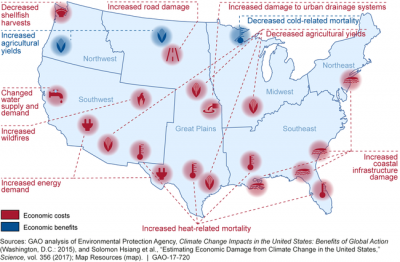This week the US Governmental Accountability Office (GAO) released CLIMATE CHANGE: Information on Potential Economic Effects Could Help Guide Federal Efforts to Reduce Fiscal Exposure, a report detailing the cost to the federal government of climate-related impacts that have already occurred, and how that cost is expected to rise. Over the last decade, extreme weather and fire events have cost the federal government over $350 billion, and a vast majority of these costs are from damage to the nation’s infrastructure.
The GAO reviewed the potential economic effects of climate change and risks to the federal government in three aspects: the methods used to estimate the potential economic effects; what is known about these effects; and the extent to which information about these effects could inform efforts to manage climate risks across the federal government.
As shown in the map below, which was created by GOA to accompany the report, many of the economic costs that directly impact infrastructure include water supply and demand, increased wildfires, increased energy demand, increased road damage, increased damage to urban drainage systems, and increased damage to coastal infrastructure.
With the conclusion of the report, the GAO recommended that the Executive Office of the President use the information provided on potential economic effects to help identify significant climate risks and craft appropriate federal responses.
This recommendation aligns with the Infrastructure Report Card’s proposed solutions to increase resilience and sustainability of our infrastructure to ensure it’s built for the future. We are already feeling the economic drag of inadequate infrastructure, and this report further underscores the need to improve our infrastructure and make strategic decisions when making these investments to ensure their longevity.
One opportunity the federal government has to address this is to establish a federal flood risk management standard to mitigate the impacts of flooding on our nation’s infrastructure. As advocates for policies that reduce risk, protect the health of the public, and maximize the public interest – including cost considerations and resilient designs – ASCE has been supportive of efforts that achieve this goal, specifically the Obama-era Federal Flood Risk Management Standard (FFRMS) that was rescinded by President Trump through an Executive Order (EO) on August 15, 2017. The FFRMS required that any new federally funded infrastructure projects in a flood plain must first and foremost consider and mitigate flood disaster risk. It was designed to end the costly and unsustainable cycle of relying on disaster relief funds to rebuild after flooding events. This pragmatic approach, which gave federal agencies the flexibility to use one of three standards for establishing the flood elevation of new infrastructure projects, ensured that taxpayer dollars were responsibly spent while also safeguarding public health.
In October 2016 and September 2017, ASCE submitted formal comments to the Federal Emergency Management Agency (FEMA) and the Tennessee Valley Authority (TVA) in response to the respective agencies’ proposed rules to implement the FFRMS. In March 2017, June 2017, and September 2017, ASCE, along with a coalition of organizations, sent letters to the White House in support of a federal flood standard. Earlier this month, Congressman Mark Sanford (R-SC) led a bipartisan congressional letter to the Administration asking them to develop a strong federal flood standard to mitigate the impacts of flooding on our nation’s infrastructure. Last week, the Attorney Generals of New York, California, Illinois, Iowa, Maryland, and the District of Columbia led a bipartisan letter to Congress urging them, too, to enact an updated federal flood standard.
Read the full GAO report CLIMATE CHANGE: Information on Potential Economic Effects Could Help Guide Federal Efforts to Reduce Fiscal Exposure.




